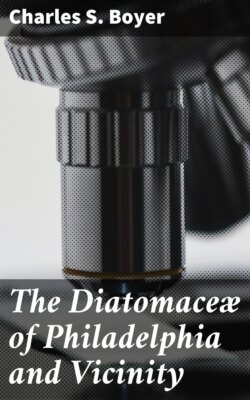Читать книгу The Diatomaceæ of Philadelphia and Vicinity - Charles S. Boyer - Страница 5
На сайте Литреса книга снята с продажи.
CLASSIFICATION
ОглавлениеTable of Contents
The few species of diatoms first discovered were included by Lyngbye, Dillwyn, and others in the genus Conferva. In 1824, the species, increased to forty-eight, were separated by Agardh into eight genera distinguished partly by their mode of growth. But little change was made until Heiberg, in 1863, advocated the division into symmetrical and asymmetrical forms. Without entering upon a general review of the later classifications, including Pfitzer's and Petit's divisions according to the number and location of the chromatophores, or the arrangement of Prof. H. L. Smith, because of the presence or absence of a raphe, or that of Mereschkowsky into motile and immotile forms, the modification of all of these methods by Schuett is here adopted, varied in accordance with certain monographs which appear to offer advantage.
It is customary, especially among writers who are familiar with other classes of plants, to decry any classification of diatoms according to the markings of their siliceous envelopes. As, however, one of the chief distinctions of the class is the possession of a more or less siliceous and indestructible frustule, and as the cell and its contents are never seen except within the valves, their variety forms the only available method of identification. The cell contents, owing to the difficulty of observing their living condition, their continued change, their lack of distinct variation and their entire absence in fossil forms, render their consideration as a complete method of classification an impossibility. If, however, the cell contents can be brought into relation with the markings of their siliceous envelope, it will be a consummation for which the future student of these complicated forms ought to be grateful. That this result is one to be expected may be inferred from the fact that the arrangement of protoplasmic masses in the interior of the cell is coincident in some cases with markings on the valve, and the character of the endochrome is assuming a certain value in accentuating the difference between such forms as Pleurosigma and Gyrosigma, or in the resemblance between Hantzschia and Nitzschia, or between Surirella and Campylodiscus. Mereschkowsky, however, states that it is necessary to be careful in "establishing the relationship between diatoms based on the resemblance of their chromatophores," and further observes that in Hantzschia amphioxys, Scoliotropis latestriata and Achnanthes brevipes, three widely separated forms, the chromatophores are essentially the same.
In one of the earliest classifications of diatoms, the individual cell received less consideration than the nature of the filament or thallus in which many species occur in the first stages of their growth. Those, however, which exist in colonies at first are, sooner or later, broken up into separate frustules, either before or at the time of their maturity or previous to conjugation, while very many species are never seen except in a free state. The union of frustules, therefore, is of secondary importance and the group must be considered as filamentous or unicellular algæ. Their relation to other algæ is not well determined. Among the Desmidiaceæ, a family of the order Conjugales, of the class Chlorophyceæ, the cells are in many forms divided by a constriction into symmetrical halves. The Conjugales are starch forming, with walls of cellulose. In the Diatomaceæ the starch is replaced by oil globules, while the walls of cellulose are more or less filled with a deposit of silica. The Conjugales, however, reproduce by zygospores and usually contain pyrenoids, as may be seen in the parietal chromatophores of Spirogyra. In the class Heterokontæ we have the reserve material in the form of oil, instead of starch, but there are no pyrenoids. To this class belongs the order Confervaceæ, in which the cells are unicellular or filamentous, and to which all of the Diatomaceæ were referred. While, therefore, Diatomaceæ have a close affinity to the Desmidiaceæ and to the Confervaceæ, the determination of their origin, one from another, or from a common ancestral type, appears to be a matter of conjecture.
